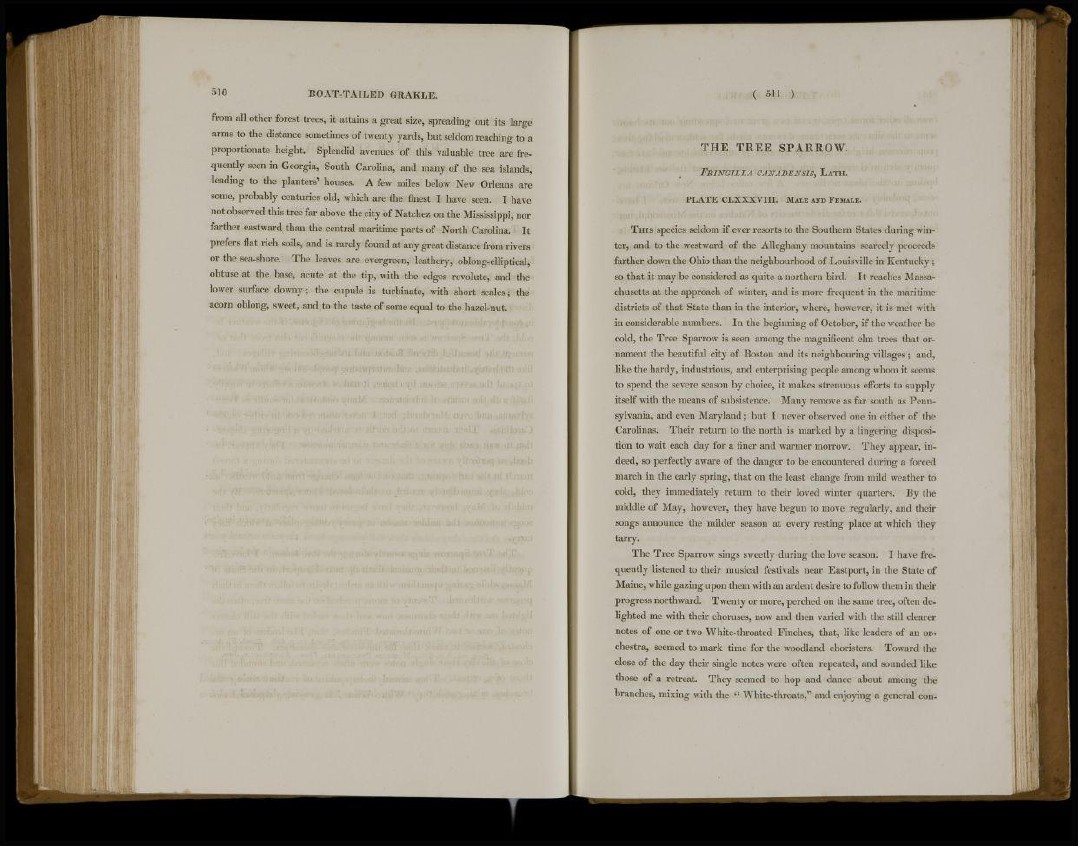
510 BOAT-TAILED GRAKLE.
from all other forest trees, it attains a great size, spreading out its large
arms to the distance sometimes of twenty yards, but seldom reaching to a
proportionate height. Splendid avenues of this valuable tree are frequently
seen in Georgia, South Carolina, and many of the sea islands,
leading to the planters' houses. A few miles below New Orleans are
some, probably centuries old, which are the finest I have seen. I have
not observed this tree far above the city of Natchez on the Mississippi, nor
farther eastward than the central maritime parts of North Carolina. It
prefers flat rich soils, and is rarely found at any great distance from rivers
or the sea-shore. The leaves are evergreen, leathery, oblong-elliptical,
obtuse at the base, acute at the tip, with the edges revolute, and the
lower surface downy; the cupule is turbinate, with short scales; the
acorn oblong, sweet, and to the taste of some equal to the hazel-nut.
( 511 )
T H E T R E E S P A R R O W .
FRINGILLA CANADENSIS, LATH.
P L A T E C L X X X V I I I . MALE AND FEMALE.
THIS species seldom if ever resorts to the Southern States during winter,
and to the westward of the Alleghany mountains scarcely proceeds
farther down the Ohio than the neighbourhood of Louisville in Kentucky;
so that it may be considered as quite a northern bird. It reaches Massachusetts
at the approach of winter, and is more frequent in the maritime
districts of that State than in the interior, where, however, it is met with
in considerable numbers. In the beginning of October, if the weather be
cold, the Tree Sparrow is seen among the magnificent elm trees that ornament
the beautiful city of Boston and its neighbouring villages; and,
like the hardy, industrious, and enterprising people among whom it seems
to spend the severe season by choice, it makes strenuous efforts to supply
itself with the means of subsistence. Many remove as far south as Pennsylvania,
and even Maryland; but I never observed one in either of the
Carolinas. Their return to the north is marked by a lingering disposition
to wait each day for a finer and warmer morrow. They appear, indeed,
so perfectly aware of the danger to be encountered during a forced
march in the early spring, that on the least change from mild weather to
cold, they immediately return to their loved winter quarters. By the
middle of May, however, they have begun to move regularly, and their
songs announce the milder season at every resting place at which they
tarry.
The Tree Sparrow sings sweetly during the love season. I have frequently
listened to their musical festivals near Eastport, in the State of
Maine, while gazing upon them with an ardent desire to follow them in their
progress northward. Twenty or more, perched on the same tree, often delighted
me with their choruses, now and then varied with the still clearer
notes of one or two White-throated Finches, that, like leaders of an orchestra,
seemed to mark time for the woodland choristers. Toward the
close of the day their single notes were often repeated, and sounded like
those of a retreat. They seemed to hop and dance about among the
branches, mixing with the " White-throats," and enjoying a general con